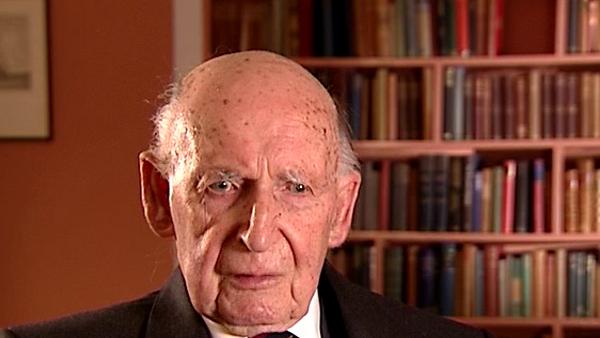NEXT STORY

Final work on flare stars
RELATED STORIES

NEXT STORY

Final work on flare stars
RELATED STORIES



Now, by that time I had become very... got to know Fred Whipple working at the Smithsonian very well, and as a matter of fact, I had... was also... had been on the board of visitors to Harvard Observatory and saw much of Whipple. And I discussed this with him and he made the interesting suggestion that the series of cameras that he was using to observe the Sputniks, the... the satellites, could be diverted to observe a particular star if I would observe simultaneously and from America to Jodrell, of course, there were long periods of mutual visibility for stars which made this work worthwhile. And so in the 1950s, I began this work in association with Fred Whipple, and we would... he would adjust his cameras to trace... We particularly concentrated on a nearby M type dwarf known as UV Ceti.
Now, UV Ceti turns out to be a double. It has a diameter of about 0.8 of that of the sun and it was known to show flares in the optical region and Whipple would record these flares with his cameras and I would observe the radio emission as the telescope tracked UV Ceti. I think UV Ceti detonation minus 18 so we had particularly in the... in the autumn period, a period of visibility, which made this work possible. Now, you must remember that the sensitivity, possible sensitivity of the equipment we had then, is far above, or... or less than anything which subsequently became possible, and there were no computers, so I set myself the problem of... of integrating by... by hand, so to speak. I laid the successive charts out on a long table and just measured the intensity of the noise and eventually found a... a bump in the records after a mammoth integration, a bump in the records, which was statistically significant, which coincided with the star flares observed by... by Whipple.
That... that was... I think that was published in Nature, I can't remember the date, but I then found that there were other places in the world which were also observing the... the optical flares from red dwarfs and I got into touch with Chugainov in... in the Soviet Union and he had a marvellous photo electrical equipment at the Crimean Observatory, and it was... I then did a long series of observations which Chugainov, in which we compared his photo electric observations from UV Ceti and... and another star known as Ross 882 YZC Canis Minoris, and again, we found this correlation and published a paper on it.
Bernard Lovell (1913-2012), British radio astronomer and founder of the Jodrell Bank Observatory, received an OBE in 1946 for his work on radar, and was knighted in 1961 for his contribution to the development of radio astronomy. He obtained a PhD in 1936 at the University of Bristol. His steerable radio telescope, which tracked Sputnik across the sky, is now named the Lovell telescope.
Title: Work on flare stars with Fred Whipple
Listeners: Megan Argo Alastair Gunn
Megan Argo is an astronomer at the University of Manchester's Jodrell Bank Observatory researching supernovae and star formation in nearby starburst galaxies. As well as research, she is involved with events in the Observatory's Visitor Centre explaining both astronomy and the history of the Observatory to the public.
Alastair Gunn is an astrophysicist at Jodrell Bank Observatory, University of Manchester. He is responsible for the coordination and execution of international radio astronomical observations at the institute and his professional research concerns the extended atmospheres of highly active binary stars. Alastair has a deep interest and knowledge of the history of radio astronomy in general and of Jodrell Bank in particular. He has written extensively about Jodrell Bank's history.
Tags: Smithsonian Institution, Harvard College Observatory, Sputnik 1, Jodrell Bank, USA, UV Ceti, Nature, Soviet Union, Crimean Astrophysical Observatory, Fred Whipple
Duration: 4 minutes, 9 seconds
Date story recorded: January 2007
Date story went live: 05 September 2008